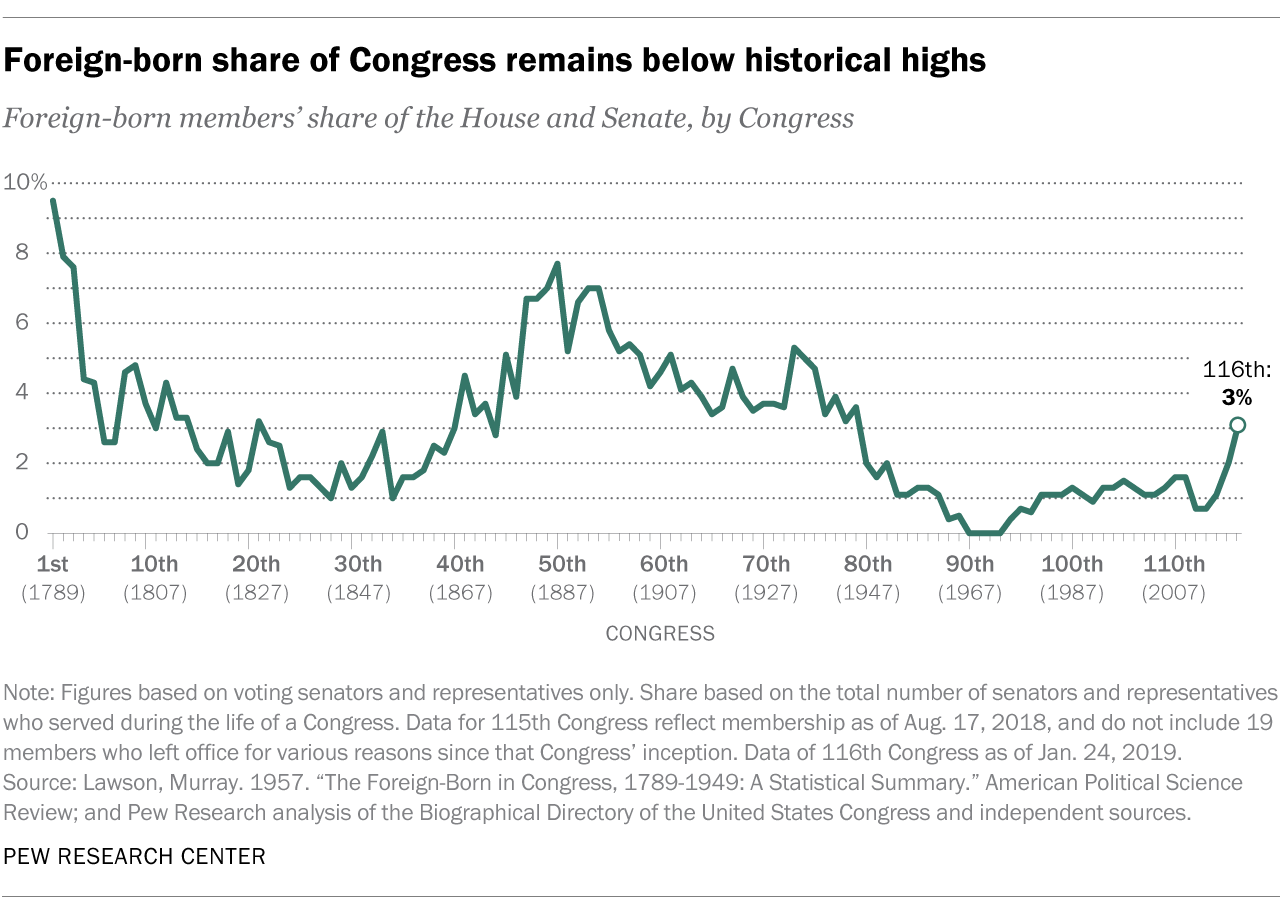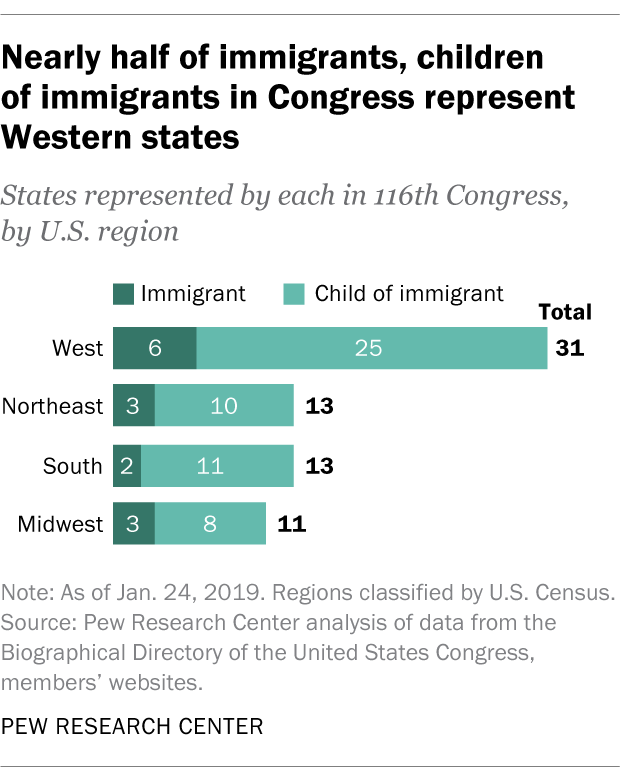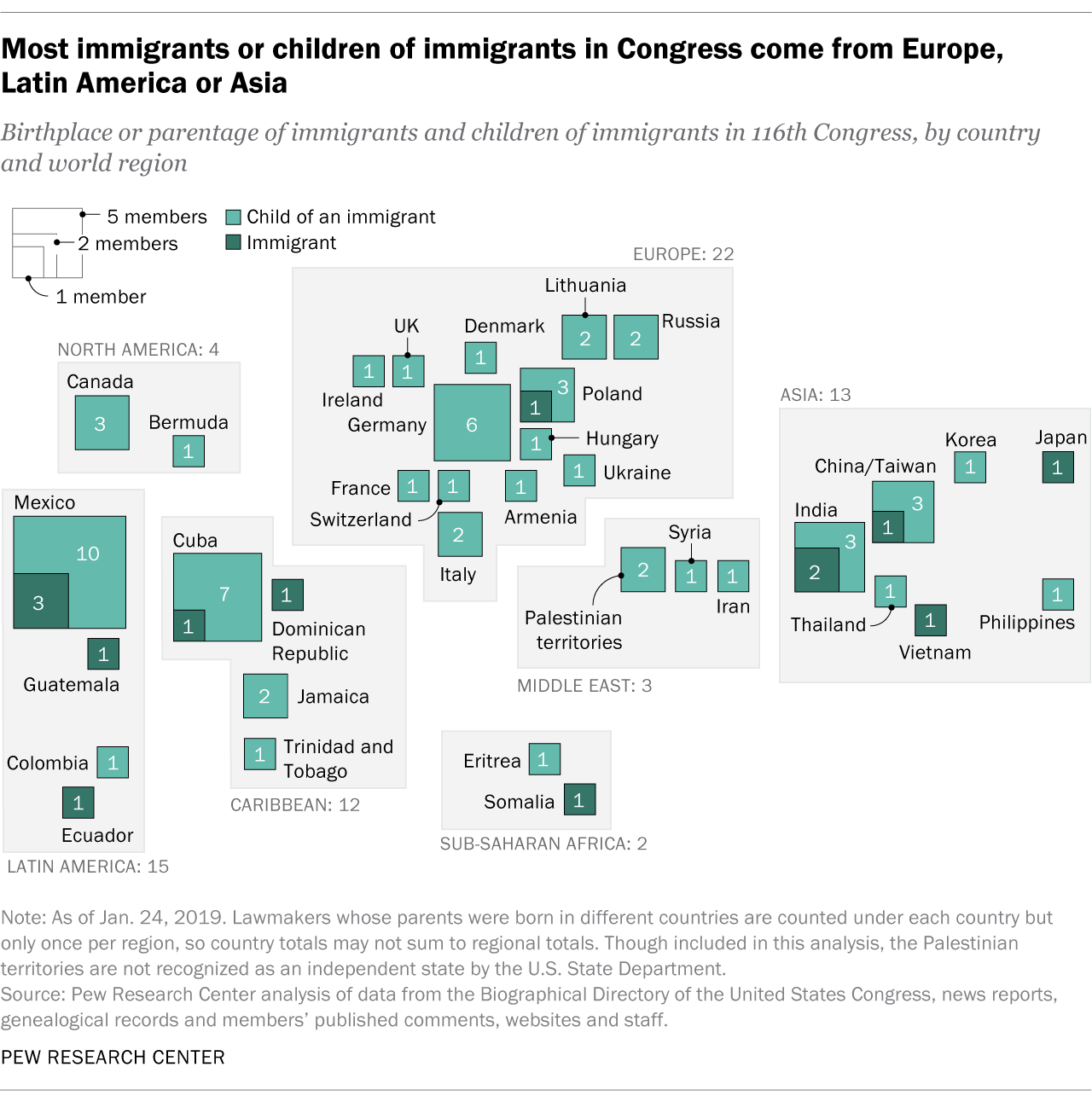
Immigrants and children of immigrants account for at least 13% of all voting members of the newly sworn in 116th Congress. These lawmakers claim heritage in 37 countries – mostly in Europe, Latin America and Asia – and are overwhelmingly Democrats, according to a Pew Research Center analysis of members’ biographical information obtained from news articles, congressional offices and other sources.
There are 52 immigrants and children of immigrants serving in the House of Representatives and 16 serving in the Senate. Counting both chambers, 57 of the 68 lawmakers who are immigrants or children of immigrants are Democrats. Ten others are Republicans, and one – Sen. Bernie Sanders of Vermont – is an independent.
November’s elections did not substantially change the share of immigrants and children of immigrants in Congress. In the last Congress, 12% of all voting members fell into this category, a slightly lower share than in the current Congress. While two immigrants and six children of immigrants from the 115th Congress are no longer serving, four of these members’ seats were filled by lawmakers who also are immigrants or children of immigrants.
While at least 13% of voting members in Congress are immigrants or children of immigrants, relatively few of these are foreign born: 13 in the House, and just one – Sen. Mazie Hirono, D-Hawaii – in the Senate. These 14 immigrant lawmakers represent just 3% of all voting members in both chambers, a slight uptick from recent Congresses but substantially below the foreign-born share of Congresses many decades ago. (For example, about 10% of members in the first and much smaller Congress of 1789-91 were foreign born. About a century later, in the 50th Congress of 1887-89, 8% of members were born abroad, according to a previous analysis.) The current share of foreign-born lawmakers in Congress is also far below the foreign-born share of the United States as a whole, which was 13.5% as of 2016.

 Immigrants and children of immigrants represent 24 states, with nearly half representing Western states. California has by far the most: 19 of the state’s 55 members are immigrants or children of immigrants. (Five members of Illinois’ delegation are immigrants or children of immigrants, the second-highest total of any state.) Looked at another way, more than a quarter of all members of Congress who are immigrants or children of immigrants represent California.
Immigrants and children of immigrants represent 24 states, with nearly half representing Western states. California has by far the most: 19 of the state’s 55 members are immigrants or children of immigrants. (Five members of Illinois’ delegation are immigrants or children of immigrants, the second-highest total of any state.) Looked at another way, more than a quarter of all members of Congress who are immigrants or children of immigrants represent California.
Europe is the most common origin region
Europe is the most common origin region for immigrant lawmakers or those who are children of immigrants: About one-third (32%) have roots in countries there. Roughly one-in-five (22%) immigrants and children of immigrants in Congress hail from countries in Latin America, and most of these – 13 – have immigrant roots in Mexico. Asia follows with 19% and the Caribbean with 18%. Collectively, 74% of immigrants and children of immigrants in Congress have origins in countries in Europe, Latin America or Asia.
Much smaller shares claim heritage in countries in the Middle East, North America and sub-Saharan Africa – each below 10%. (Some lawmakers in this analysis are tallied under more than one country and region. For example, Rep. Anthony Brown, D-Md., is the child of a Caribbean father and a European mother.)
 Several lawmakers are immigrants who came to the U.S. with family to evade oppressive regimes or violence in other countries. Newly elected Rep. Ilhan Omar, D-Minn., was born in Mogadishu, Somalia, and fled with her family in 1991 after the country’s civil war started. Her family spent four years in a refugee camp in Kenya and later moved to America, where she became a citizen in 2000. Rep. Tom Malinowski, D-N.J., was born in communist Poland before coming to the U.S. at age 6 with his mother.
Several lawmakers are immigrants who came to the U.S. with family to evade oppressive regimes or violence in other countries. Newly elected Rep. Ilhan Omar, D-Minn., was born in Mogadishu, Somalia, and fled with her family in 1991 after the country’s civil war started. Her family spent four years in a refugee camp in Kenya and later moved to America, where she became a citizen in 2000. Rep. Tom Malinowski, D-N.J., was born in communist Poland before coming to the U.S. at age 6 with his mother.
Others had parents who fled their native countries. Sen. Michael Bennet, D-Colo., was born to a Polish mother who survived the Holocaust and came to the U.S. in 1950. Rep. Joe Neguse, also a Democrat representing Colorado, was born to Eritrean parents who fled their country in 1980 when it was embroiled in war with Ethiopia.
Under the U.S. Constitution, an immigrant taking office in the House must be a U.S. citizen for seven years or more, age 25 or older and living in the state where he or she is elected. Nine years of citizenship are required to serve in the Senate, and the person must be 30 or older and live in the represented state when elected.
In this analysis, we examined lawmakers’ birthplaces and parentage through news stories, obituaries, candidate statements, and congressional and genealogical records, as well as contacting congressional staff. Our count does not include members of Congress who were born outside the U.S. to American parents and gained U.S. citizenship after meeting legal requirements. Our tally also does not include members who were born (or whose parents were born) in U.S. territories, such as Puerto Rico, nor on U.S. military bases out of the country. In addition, one disputed seat in the House – North Carolina’s 9th District – is not included in the total number of voting seats.
If you know of an additional legislator not included on our list, send us an email at [email protected].
Research assistant Virginia Villa contributed to this analysis.
Immigrants, children of immigrants in the 116th U.S. Congress
| Name | Immigrant or child of an immigrant | Parent’s or member’s country of origin | Party | Office | State |
|---|---|---|---|---|---|
| Amash, Justin | Child | Mother: Syria; Father: Palestinian terr. | Republican | Representative | MI |
| Barragán, Nanette | Child | Both parents: Mexico | Democrat | Representative | CA |
| Bennet, Michael | Child | Mother: Poland | Democrat | Senator | CO |
| Bera, Ami | Child | Both parents: India | Democrat | Representative | CA |
| Blumenthal, Richard | Child | Father: Germany | Democrat | Senator | CT |
| Boyle, Brendan | Child | Father: Ireland | Democrat | Representative | PA |
| Brown, Anthony | Child | Mother: Switzerland; Father: Cuba | Democrat | Representative | MD |
| Burgess, Michael | Child | Father: Canada | Republican | Representative | TX |
| Butterfield, G.K. | Child | Father: Bermuda | Democrat | Representative | NC |
| Carbajal, Salud | Immigrant | Mexico | Democrat | Representative | CA |
| Cárdenas, Tony | Child | Both parents: Mexico | Democrat | Representative | CA |
| Chu, Judy | Child | Mother: China | Democrat | Representative | CA |
| Clarke, Yvette | Child | Both parents: Jamaica | Democrat | Representative | NY |
| Correa, Lou | Child | Both parents: Mexico | Democrat | Representative | CA |
| Cox, TJ | Child | Mother: Philippines; Father: China | Democrat | Representative | CA |
| Cruz, Ted | Child | Father: Cuba | Republican | Senator | TX |
| Cuellar, Henry | Child | Father: Mexico | Democrat | Representative | TX |
| DeLauro, Rosa | Child | Father: Italy | Democrat | Representative | CT |
| Diaz-Balart, Mario | Child | Both parents: Cuba | Republican | Representative | FL |
| Duckworth, Tammy | Child | Mother: Thailand | Democrat | Senator | IL |
| Durbin, Dick | Child | Mother: Lithuania | Democrat | Senator | IL |
| Eshoo, Anna | Child | Mother: Armenia; Father: Iran | Democrat | Representative | CA |
| Espaillat, Adriano | Immigrant | Dominican Republic | Democrat | Representative | NY |
| Gallego, Ruben | Child | Mother: Colombia; Father: Mexico | Democrat | Representative | AZ |
| García, Jesús | Immigrant | Mexico | Democrat | Representative | IL |
| Gomez, Jimmy | Child | Both parents: Mexico | Democrat | Representative | CA |
| Gonzalez, Anthony | Child | Father: Cuba | Republican | Representative | OH |
| Grijalva, Raúl | Child | Father: Mexico | Democrat | Representative | AZ |
| Harris, Andy | Child | Mother: Ukraine; Father: Hungary | Republican | Representative | MD |
| Harris, Kamala | Child | Mother: India; Father: Jamaica | Democrat | Senator | CA |
| Heinrich, Martin | Child | Father: Germany | Democrat | Senator | NM |
| Hirono, Mazie | Immigrant | Japan | Democrat | Senator | HI |
| Horsford, Steven | Child | Mother: Trinidad | Democrat | Representative | NV |
| Houlahan, Chrissy | Child | Father: Poland | Democrat | Representative | PA |
| Hoyer, Steny | Child | Father: Denmark | Democrat | Representative | MD |
| Jayapal, Pramila | Immigrant | India | Democrat | Representative | WA |
| Khanna, Ro | Child | Both parents: India | Democrat | Representative | CA |
| Kilmer, Derek | Child | Mother: Germany | Democrat | Representative | WA |
| Kim, Andy | Child | Both parents: South Korea | Democrat | Representative | NJ |
| Krishnamoorthi, Raja | Immigrant | India | Democrat | Representative | IL |
| Lieu, Ted | Immigrant | Taiwan | Democrat | Representative | CA |
| Lowenthal, Alan | Child | Mother: Russia | Democrat | Representative | CA |
| Malinowski, Tom | Immigrant | Poland | Democrat | Representative | NJ |
| Menendez, Robert | Child | Both parents: Cuba | Democrat | Senator | NJ |
| Meng, Grace | Child | Both parents: China/Taiwan | Democrat | Representative | NY |
| Mooney, Alexander | Child | Mother: Cuba | Republican | Representative | WV |
| Mucarsel-Powell, Debbie | Immigrant | Ecuador | Democrat | Representative | FL |
| Murphy, Stephanie | Immigrant | Vietnam | Democrat | Representative | FL |
| Napolitano, Grace | Child | Mother: Mexico | Democrat | Representative | CA |
| Neguse, Joe | Child | Both Parents: Eritrea | Democrat | Representative | CO |
| Omar, Ilhan | Immigrant | Somalia | Democrat | Representative | MN |
| Peters, Gary | Child | Mother: France | Democrat | Senator | MI |
| Risch, James | Child | Father: Germany | Republican | Senator | ID |
| Rubio, Marco | Child | Both parents: Cuba | Republican | Senator | FL |
| Ruiz, Raul | Immigrant | Mexico | Democrat | Representative | CA |
| Sánchez, Linda | Child | Both parents: Mexico | Democrat | Representative | CA |
| Sanders, Bernie | Child | Father: Poland | Independent | Senator | VT |
| Sarbanes, John | Child | Mother: UK | Democrat | Representative | MD |
| Schakowsky, Janice | Child | Mother: Russia; Father: Lithuania | Democrat | Representative | IL |
| Schatz, Brian | Child | Father: Canada | Democrat | Senator | HI |
| Sires, Albio | Immigrant | Cuba | Democrat | Representative | NJ |
| Speier, Jackie | Child | Father: Germany | Democrat | Representative | CA |
| Suozzi, Thomas | Child | Father: Italy | Democrat | Representative | NY |
| Thune, John | Child | Mother: Canada | Republican | Senator | SD |
| Tlaib, Rashida | Child | Both Parents: Palestinian territories | Democrat | Representative | MI |
| Torres, Norma | Immigrant | Guatemala | Democrat | Representative | CA |
| Vargas, Juan | Child | Both parents: Mexico | Democrat | Representative | CA |
| Wyden, Ron | Child | Both parents: Germany | Democrat | Senator | OR |
Source: Pew Research Center analysis of data from the Biographical Directory of the United States Congress, news reports, genealogical records and members’ published comments, websites and staff.
TOPICS: CONGRESS, FEDERAL GOVERNMENT, DEMOGRAPHICS, COUNTRY OF ORIGIN, IMMIGRATION







